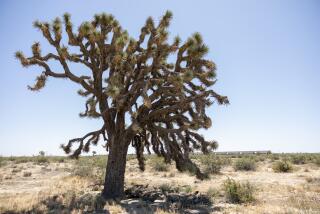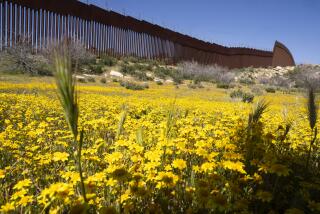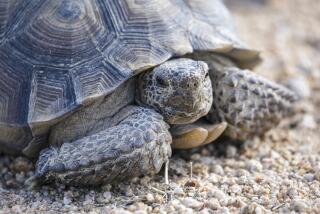Deserts
- Share via
Whether it’s the dunes of the Sahara, the brilliant-orange sands of the Australian outback, or the painted deserts of the American Southwest, deserts cover 20% of the Earth’s surface and are second only to rain forests in diversity of wildlife. Animals and plants have learned to survive and thrive in this challenging environment. To learn more about deserts, use the direct links on the Times Launchpoint Web site:
http://ukobiw.net./launch point/
Level 1
Digital Desert Library: Scientists consider deserts to be those areas where more water is lost through evaporation than is gained through rainfall. Try some fun activities that teach you about the animals and plants that live in the Chihuahuan Desert, the largest desert in the United States.
https://horizon.nmsu.edu/ddl/welcome.html
*
Desert Biome: Most deserts are found 30 degrees north and south of the equator. Take a journey into an Israeli desert, find out how deserts are created, and learn about cold deserts such as those in Peru, China and Iran.
https://www.mobot.org/MBGnet/vb/desert/
*
Arizona Sonoran Desert Pictures: The desert is home to many creatures: baby elf owls, velvet ants, road runners, Gila monsters and javelinas. Discover the plants and animals of the desert.
https://www.goldcanyon.com/oldhtml/imagesf.htm
Level 2
The Living Desert--Deserts of the World: Scirocco, santana and dust devils are just a few of the names for the strong desert winds that sculpt sand dunes as well as distribute seeds. Meet desert creatures and view a map of the world’s 12 major deserts.
https://www.livingdesert.org/deserts/deserts.htm
*
The Sonoran Desert: The extensive root system of the saguaro cactus allows it to store water from occasional rainstorms to use throughout the year. Find out how other plants and animals survive in the Sonoran Desert, the hottest in North America.
https://www.blm.gov/education/sonoran/hot.html
*
Desert USA Magazine: “Desert life desertification” is the term used for lands that are less able to support plant and animal life due to man-made causes like overgrazing and improper irrigation. Find out about the desert ecosystem, geology, history and more in this comprehensive set of resources.
https://www.desertusa.com/life.html
Level 3
One World Magazine: Deserts: Experience the people and cultures of deserts from around the world through photos, stories, paintings and articles such as “The Physics of Blown Sand,” “In Cahoots with Coyote” and “Desert Dwellings, Desert Claims.”
https://www.envirolink.org/oneworld/focus/deserts/tocintro.htm
*
Desert: Explore the Sonoran Desert through this guided tour that explains the area’s history and geography, and introduces you to local residents such as the jack rabbit, the cactus wren and the turkey vulture.
https://www.scenicdrive.org/aboutthe.htm#History
*
The High Desert Museum: Animals: The Latin name for the turkey vulture is Cathartes aura, which means “the Great Purifier.” Find out how birds and animals contribute to life in the desert.
https://www.highdesert.org/birds.htm
EXPLORER’S QUEST: How do the pleats of the barrel cactus help it survive?
CLUE: See Desert BiomeFind What You Need to Know: Have a project on California history? Need help doing a math problem? Launch Point now covers more than 50 topics for getting your schoolwork done. Go to http://ukobiw.net./launchpoint/ for the full list of subjects and direct links to the best Internet sites.
Answer to last week’s Quest: A spacecraft can increase speed by flying alongside a planet to get a “gravity assist.” Launch Point is produced by the UC Irvine department of education, which reviews each site for a ppropriateness and quality. Even so, parents should supervise their children’s use of the Internet. This column was designed by Anna Manring and Larry MacPhee.
More to Read
Sign up for The Wild
We’ll help you find the best places to hike, bike and run, as well as the perfect silent spots for meditation and yoga.
You may occasionally receive promotional content from the Los Angeles Times.






